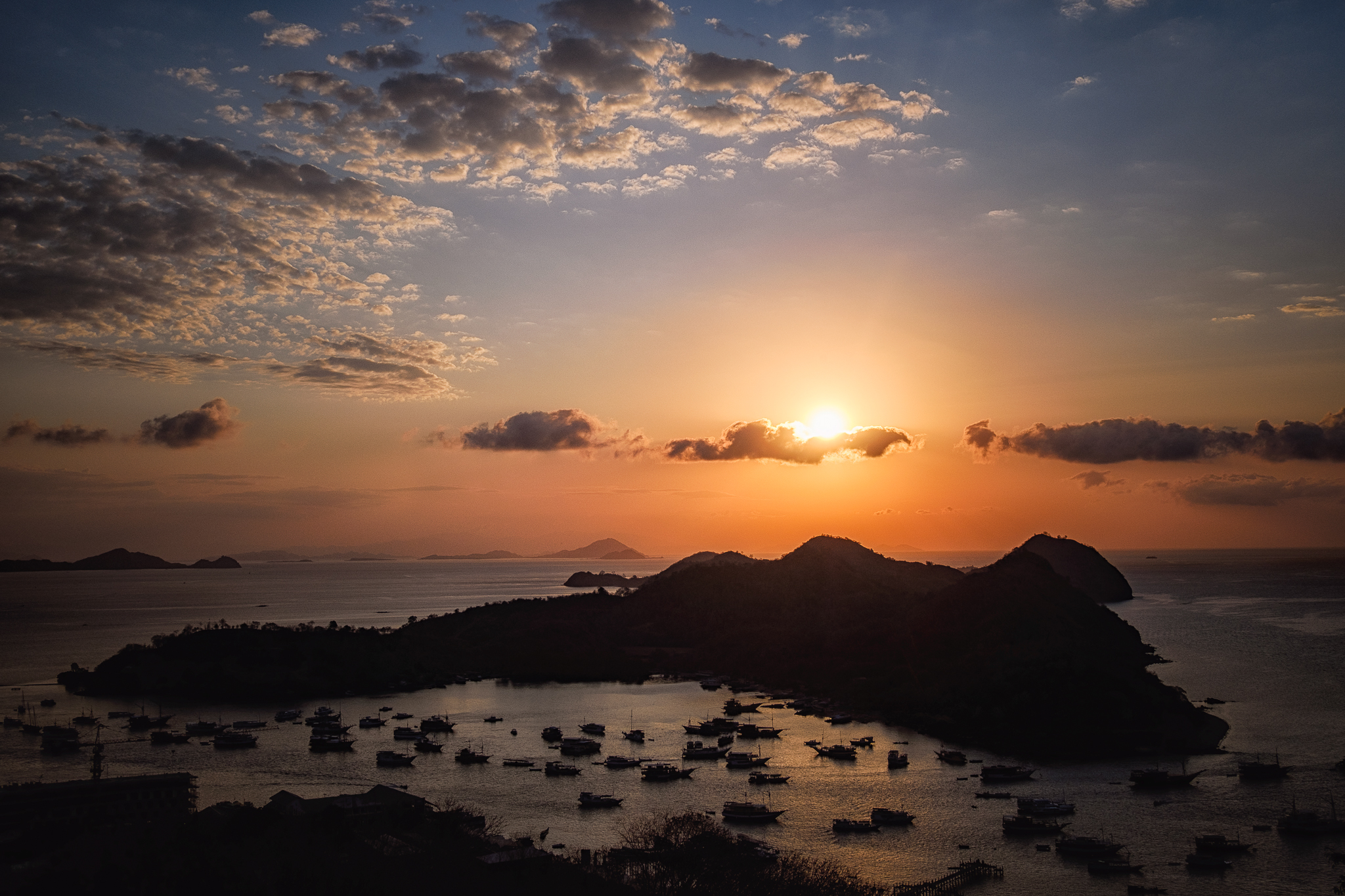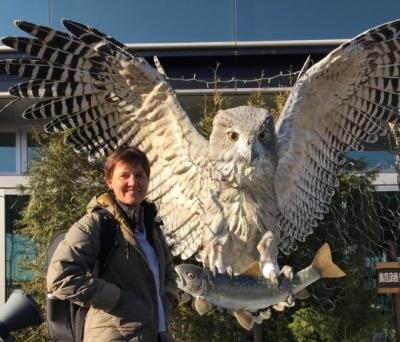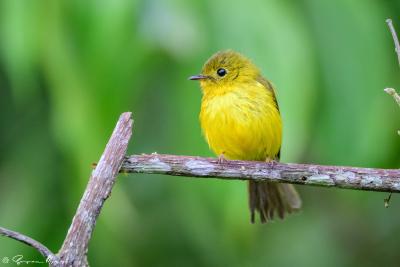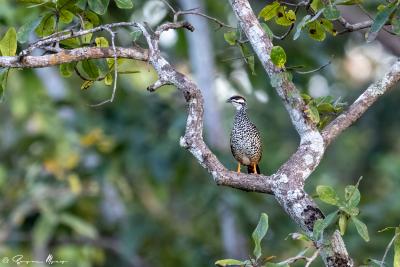Indonesia: The Lesser Sunda Islands
Sumba, Timor and Flores
-
Sep 13 to Oct 3 2026
Susan Myers
Tour Price to be Determined

Tour Price to be Determined
The islands of Nusa Tenggara, or the Lesser Sundas, stretch across the Java Sea north of Australia, between the islands of New Guinea and Bali. They are part of a unique region known as Wallacea, which contains a distinctive fauna representing a mix of Asian and Australian species. The tropical dry climate has given rise to vegetation that is strikingly different from the rest of the Indonesian archipelago. More than 70 endemic bird species live in the seasonally dry monsoon forests and savanna woodlands, and new species are still being discovered.
The region is not heavily visited by Western tourists, but accommodations range these days are good to excellent, and the birding is comfortable on mostly quiet roads and wide, flat trails. The pace of life in the Lesser Sundas is relatively slow, and the locals are laid-back and friendly.
Day 1: The tour begins this evening in Denpasar, Bali. Night in Kuta, Bali.
Susan’s knowledge of Indonesian birds is first rate. She also spends time explaining the local culture and, of course, speaks fluent Indonesian. In fact, I liked the balance between birding and a few other local culture activities, and the siesta time during the heat of the day. She also coped well with the inevitable small problems. Well done Susan, and thank you once again.Keith Morrell, Oct 2018
Day 2: This morning we’ll fly past steaming volcanoes and a myriad of emerald green islands set in turquoise seas to the dry and sparsely populated island of Sumba. Each island in Indonesia is home to unique cultures and languages, and Sumba is no different: the various Sumbanese tribes are famous for their daring horseback riding and their unusual style of fabric design known as ikat. Sumba residents are mainly Dutch Calvinists or Roman Catholics, but underlying those traditions is a strong adherence to the age-old animistic practice known as Marapu, represented throughout the island in the form of beautiful architecture, complex ceremonies, and megalithic tombs.
In terms of avifauna, Sumba has a low diversity of birds but an extraordinary distinctiveness arising from the mixture of Asian and Australasian influences. Most of the forests here are deciduous monsoon forests—in other words, low and open with a warm but dry climate.
After checking into our hotel in the capital, Waingapu, we’ll travel a short distance out of the city to the Yumbu Grasslands, the best site for the scarce and highly local endemic Sumba Buttonquail. Here birds such as Indonesian Honeyeater, Horsfield’s Bushlark, Zitting Cisticola, Brown Quail, and Zebra Finch are common, and Australian Hobby is also a possibility, indicating our location on the border between the Asian and Australasian regions. Night in Waingapu.
Day 3: This morning will travel further east of Yumbu, the permanent freshwater wetlands of Kadumbul are outstanding for waders and waterfowl. Here we should encounter large numbers of Black and Little Pied Cormorants, Purple Heron, Great and Intermediate Egrets, Wandering Whistling-Duck, the endemic Sunda Teal, Purple Swamphen, Great Crested, Whiskered, and White-winged Terns, Clamorous Reed-Warbler, and Timor Zebra Finch. Less common but always possible are Australian Pratincole and Oriental Plover.
After lunch back in Waingapu we’ll drive straight to the charming village of Lewa, where we’ll begin our birding in the surrounding forests. We’ll return to Waingapu after some owling. Night in Waingapu.
Day 4: We’ll spend the day near Lewa in a remnant patch of forest that is terrific for endemics such as Red-naped Fruit-Dove, Sumba Hornbill, Marigold Lorikeet, Sumba Myzomela, and Sumba Jungle-Flycatcher, as well as more widespread regional endemics: Blood-breasted Flowerpecker, Apricot-breasted Sunbird, Lesser Wallacean Drongo, the simply gorgeous Chestnut-backed Thrush, and the incomparable Elegant Pitta. We could also encounter Variable Goshawk, Black-naped Fruit-Dove, Australian Koel, Red-cheeked Parrot, Great-billed Parrot, Blue-tailed and Rainbow Bee-eaters, Arafura Fantail, and Black-naped Oriole. Golden Whistler is an extremely interesting species in the Lesser Sundas, with highly variable forms (species?) on all three islands: Sumba fulviventris, Timor calliope, and Flores fulvotincta. In the evening we’ll look for the endemic Mees’s Nightjar, known for its distinctive calls. We’ll also make another effort to find the fascinating and endemic Little Sumba and Sumba Boobooks. Night in Waingapu.
Day 5: Manupeu Tanadaru National Park lies about seven kilometers west of Lewa. This newly established park protects some excellent forest, especially along the river near the village of Padiratana. The park is another great place for a host of Sumba endemics and other specialties including Sumba Flycatcher, Sumba Green-Pigeon, Sumba Cuckoo-shrike (Pale-shouldered Cicadabird), and Sumba Brown Flycatcher. Small flocks of Sumba (Rainbow) Lorikeets are often seen flying along the river, and more widespread species such as Brown Goshawk (rare in Asia), Spotted Kestrel, Emerald Dove, Barred Dove, Gray Tit (a recent split from Great Tit), and Common Kingfisher are all possible. Night in Waingapu.
Days 6 -7: This morning, we’ll take the short but scenic flight over volcanic islands dotted in the turquoise tropical seas to Kupang in West Timor. From there we’ll take another short flight to remote Rote Island. After checking in to our hotel we’ll start our explorations of the island. Highlights here should include Rote Leaf Warbler, Rote Myzomela and Rote Boobook, which we’ll look for in the early evening. Some birds that are easier to find here than on neighboring Timor include Black Cuckoo-Dove and the jewel like Jonquil Parrot. Night in Rote.
Day 8: We’ll take a morning flight back to Kupang and after checking into our hotel, we’ll proceed to Bipolo Forest. Bipolo Forest, near the village of Bipolo, has some of the best birding in the region. The road along the eastern edge of the forest leads to rice paddies and ends at shrimp ponds that are ideal for a range of open-country and wading birds. We’ll bird along the road and on some easy, flat trails in search of Yellow-crested Cockatoo, the increasingly scarce Olive-shouldered Parrot, the gorgeous Cinnamon-banded Kingfisher (sure to be a trip highlight), the equally stunning Orange-banded Thrush, Timor Blue-Flycatcher, and the fascinating Timor Stubtail. This area simply abounds with birds, including Black-backed Fruit-Dove, Slaty Cuckoo-Dove, Fawn-breasted Whistler, White-shouldered Triller, Streak-breasted and Yellow-eared Honeyeaters, Timor Friarbird, Timor (Olive-brown) Oriole, Timor (Green) Figbird, Greater Wallacean Drongo, Flame-breasted Sunbird, Thick-billed Flowerpecker (the distinctive subspecies here might be a future split), Red-chested Flowerpecker, and Ashy-bellied White-eye.
In the nearby rice paddies, or sawah, there is more excellent birding, and our efforts here could yield Lesser Coucal, Barred Buttonquail, Tree Martin, Golden-headed Cisticola, Black-faced Munia, Nutmeg Mannikin, and the highly sought-after Five-colored Munia and Timor Sparrow. Other possibilities at the neighboring shrimp farms include White-faced Heron, White-headed Stilt, Red-capped Plover, Red-necked Stint, Sharp-tailed and Curlew Sandpipers, and Australian Gull-billed Tern. Night in Kupang.
Day 9: We’ll visit Camplong Forest today, west of Kupang. It’s a busy area but the birding can be very good. This mid-elevation forest around a village holds birds such as Marigold Lorikeet, Timor Bushchat, Plain Gerygone, Black-breasted Myzomela, Timor Leaf-Warbler, and Northern Fantail. Small flocks of the babbler-like Timor (Spot-breasted) Dark-eye move through the midstorey, and we’ll make a particular effort for the unusual, but often infuriating, endemic Buff-banded Bushbird with its distinctive loud call. In the evening we’ll look for the endemic Streaked (Timor) Boobook. Night in Kupang.
Day 10: We’ll leave early for the town of Soe at the base of Gunung Mutis, the highest mountain in Timor. En route we’ll bird some more around Kupang and stop at Oelnasi, a small area of monsoon forest and a great place for Timor Black Pigeon and Bar-necked Cuckoo-Dove. There is also a chance for Black-banded Flycatcher, Timor Sparrow, Black-banded Fruit-Dove, and Timor Bushchat. Night in Soe.
Day 11: The forests of Gunung Mutis, dominated by native Eucalyptus trees, are well worth a full day of birding. The road from Soe is rough, but the mountain is misty and cool and its beautiful forest holds some real treats, such as Metallic Pigeon, the rare Timor and Pink-headed Imperial-Pigeons, Olive-headed Lorikeet and the rather difficult Iris Lorikeet, Tricolored Parrotfinch, and the very distinctive form of Pygmy Wren-Babbler, which is surely an endemic species. We may also encounter Red Junglefowl (introduced here), Oriental Pipit, Black-faced Cuckoo-shrike, Snowy-browed Flycatcher, Gray-headed Canary-Flycatcher, Pied Bushchat, and Long-tailed Shrike. Night in Soe.
Day 12: We’ll return to Kupang with stops at Camplong or Bipolo, depending on our ornithological needs. Night in Kupang.
Day 13: We’ll fly this morning to Ruteng on the island of Flores.Most of the 1.5 million Floresians (speaking at least eight unique languages!) are Catholics as a result of the influence of Portuguese missionaries and traders in the 16th century. In fact, Flores means “flowers” in Portuguese and gives some indication of the beauty of this island.
From the airport we’ll head straight to Poco Ranaka, a steep mountain on the ridge to the south of Ruteng. We’ll drive as far as possible up the road and then walk downhill on a gentle grade. This is great birding in rich forest with views over the town of Ruteng and its surroundings. Some of the birds we might encounter include Bonelli’s Eagle, Green Junglefowl, Barred Cuckoo-Dove, Dark-backed Imperial-Pigeon, Fork-tailed Swift, Flores Jungle-Flycatcher, Pygmy Wren-Babbler, Black-fronted Flowerpecker, White-browed Dark-eye, Sunda (Scaly-crowned) Honeyeater, Tawny-breasted Parrotfinch, and Yellow-breasted Warbler. The astounding Bare-throated Whistler is happily common and extremely vocal here, and with luck we may find the endemic but rare Flores Hawk-Eagle. Night in Ruteng.
Day 14: This morning we’ll head to Golo Lusang for the impressive dawn chorus dominated by the remarkable vocalisations of the Bare-throated Whistlers. Birding along the road we should get some good looks at this amazing birds as well as Dark-backed Imperial Pigeons, Black-backed Fruit Doves and Barred Cuckoo-doves. With luck we’ll find the shy Flores Lorikeet as well as endemic Yellow-browed Dark-eye, Flores Leaf Warbler, Yellow-breasted Warbler, Pale-shouldered Cicadabird, Scaly-crowned Honeyeater, Mountain and Yellow-spectacled White-eye, and Golden-rumped Flowerpecker. Night in Ruteng.
Day 15: Today we’ll leave early to drive tothe remnant lowland forest of Kisol, two hours drive away on the south coast of the island. At Kisol we’ll search for the superb White-rumped Kingfisher, Flores Lorikeet, Flores (Thick-billed) Dark-eye, and the elusive Chestnut-capped Thrush—a beautiful Zoothera. Our main targets here are the rather strange Flores Crow and the recently described Flores Hawk-Eagle. On our return journey we’ll stop along the way at Ranamese Lake, a small volcanic lake about an hour’s drive from Ruteng.Here we’ll try for the elusive Flores Scops Owl and maybe Wallace’s Scops Owl, if we hear it. Night in Ruteng.
Days 16-17: We’ll drive from Ruteng today to Pagal where we’ll again bird along a relatively quiet road through forested slopes in hopes of more Flores and Lesser Sundas endemics. This is a great place for the handsome White-rumped Kingfisher, which we’ll try to coax into view. This is also a good area for the very neat Chestnut-backed Thrush as well as our most hoped for target the scarce Wallace’s Hanging-parrot, which is attracted to the flowering Erythrina variegata trees that are quite common here. We’ll also be on the lookout for Crested Dark-eye, Black-fronted Flowerpecker and more widespread but nevertheless appealing species such as Small Minivets and the distinctive local form of Bonelli’s Eagle. We’ll also drop into Ranamese again - this wonderfully scenic area holds some splendid birds, including both endemic scops-owls. We’ll be on the lookout for Ruddy Cuckoo-Dove, Sunda Cuckoo, Wallacean Cuckoo-shrike, Flores Minivet, the distinctive subspecies of Mountain Tailorbird, Flores Leaf-Warbler, Brown-capped Fantail, Oriental White-eye (yellow-bellied form), Yellow-spectacled White-eye, and Golden-rumped Flowerpecker. On the lake itself, Pacific Black Duck should be common, but one of our main targets will be the fascinating and cute but skulking Russet-capped Tesia. Nights in Ruteng.
Day 18: Today we’ll leave Ruteng early and head to Pocondeki Hill, which contains exceptional forest. A level track gives good access to the forest, and we’ll also be on the hunt for Flores (Rainbow) Lorikeet, Rufous-chested Flycatcher, and Crested Dark-eye. Our main aim today will be found at Puar Lolo, a tiny patch at mid-elevation surrounding a telecom station, the best site for the shy and retiring Flores Monarch. After a picnic lunch we’ll hit the road again and drive to Labuan Bajo, gateway to Komodo Island. Later we’ll make a short detour up the Pocowanka Road, which is a last stronghold for the diminutive Wallace’s Hanging-Parrot. Night in Labuan Bajo.
Day 19: The fabled home of the Komodo Dragon is a spectacular two-hour boat ride from Labuan Bajo. We’ll have a great chance of seeing these amazing creatures and, as well, a healthy population of Yellow-crested Cockatoos, now highly endangered due to the cage bird industry. We may also find Great and Lesser Frigatebirds, Great-billed Heron, Pacific Reef-Heron, White-bellied Sea-Eagle, Beach Thick-knee, Lesser Crested and Bridled Terns, Green Junglefowl, and Green Imperial-Pigeon. Collared and Sacred Kingfishers are common, and this is a great place to observe the extraordinary Orange-footed Scrubfowl at work on its mound. On our way back, we’ll make a stop in a small cove where those who are interested can snorkel on one of the most spectacularly species-rich reefs in the world! Night in Labuan Bajo.
Day 20: Depending on the time of our flight back to Denpasar, we may do some more birding along the Pocowanka Road or finish off our tour watching waders at some mudflats in Bali, where Javan Plover is always a possibility. We’ll have our farewell dinner tonight in the delightful surroundings of our hotel. Night in Kuta, Bali.
Day 21: The tour concludes this morning in Denpasar, Bali.
Note: The information presented here is an abbreviated version of our formal General Information for this tour. Its purpose is solely to give readers a sense of what might be involved if they take this tour. Although we do our best to make sure that what follows here is completely accurate, it should not be used as a replacement for the formal document which will be sent to all tour registrants, and whose contents supersedes any information contained here.
ENTERING INDONESIA: A passport valid for at least six months beyond your planned departure and with at least two blank pages for entry and exit stamps is required for United States citizens to enter Indonesia. For stays of 30 days or less in Indonesia, a visa can be obtained upon entry at $20 USD per person (subject to change).
Citizens of other countries should check with their consulate/embassy for instructions.
COUNTRY INFORMATION: You can review the U.S. Department of State Country Specific Travel Information here: https://travel.state.gov/content/travel.html. Review foreign travel advice from the UK government here: https://www.gov.uk/foreign-travel-advice and travel advice and advisories from the Government of Canada here: https://travel.gc.ca/travelling/advisories.
PACE OF THE TOUR: Our birding days will normally begin relatively early in order to avoid the heat of midday when bird activity is also very low. We’ll then bird most of the day while warmer and light, with rests after lunch. There are some drives of three to four hours, and four internal flights. Most of the driving is on reasonably well-surfaced roads.
The longest walk will be at Lewa in Sumba, where we take trails into the forest for perhaps four kilometers (about 2.5 miles) and possible a bit further There are some inclines as it is a hilly area, though not steep, and here we’ll walk at a very relaxed pace. Mostly the walking is fairly easy, on flat or downhill terrain with plenty of stops for birding. Very often we’ll be birding from or close to the vehicle. It is hot and humid in the lowland areas, with maximum temperatures of about 30C, and sometimes lower.
HEALTH: The Centers for Disease Control and Prevention (CDC) recommends that all travelers be up to date on routine vaccinations. These include measles-mumps-rubella (MMR) vaccine, diphtheria-tetanus-pertussis vaccine, varicella (chickenpox) vaccine, polio vaccine, and your yearly flu shot.
They further recommend that most travelers have protection against Hepatitis A and Typhoid. The Typhoid vaccination is particularly important because of the presence of S. typhi strains resistant to multiple antibiotics.
Please contact your doctor well in advance of your tour’s departure as some medications must be initiated weeks before the period of possible exposure.
The most current information about travelers’ health recommendations can be found on the CDC’s Travel Health website at http://wwwnc.cdc.gov/travel/destinations/traveler/none/indonesia.
Malaria: The CDC recommends a malaria prophylaxis. Please consult your physician.
Yellow Fever: There is no risk of Yellow Fever. Proof of a valid Yellow Fever vaccination is required only if you are arriving from a country where Yellow Fever is endemic.
Elevation: Most of our birding will be done at or close to sea level, except on Gunung Mutis at 7963 feet and a couple of sites on Flores, where we’ll bird along roads at no more than 4000 feet.
Water: All water including tap water is NOT potable. Bottled water will be provided throughout the tour. In many cases however you can safely enjoy the salads, fresh fruit and vegetables. Your leader will advise.
Smoking: Smoking is prohibited in the vehicles or when the group is gathered for meals, checklists, etc. If you are sharing a room with a non-smoker, please do not smoke in the room. If you smoke in the field, do so well away and downwind from the group. If any location where the group is gathered has a stricter policy than the WINGS policy, that stricter policy will prevail.
Miscellaneous: Leeches are rarely a problem on this tour but there is the potential for chiggers. We suggest treating your clothing with permethrin. Most of our birding will be done at or close to sea level, except on Gunung Mutis at 7963 feet and a couple of sites on Flores, where we’ll bird along roads at no more than 4000 feet.
CLIMATE: During the tour, we will experience a wide range of temperatures and climate, from the 70s, high 80s and 90s in the lowlands, to as low as 55 degrees at higher elevations. It is always possible we’ll encounter some rain. Generally it will be cooler in the morning and warm to hot, but dry at midday. At the higher altitudes of Gunung Mutis and other sites it will be noticeably cooler. A light sweater for the evening, especially if we go on a night drive, will be welcome.
ACCOMMODATIONS: Our accommodations are Western-style hotels throughout and comfortable with modern facilities and air conditioning.
Inexpensive laundry facilities are available at most of our accommodations.
WiFi: Free wifi is generally available in the hotels in larger towns. Most require a password, which we’ll receive on check-in. In the more remote areas it will be difficult to find internet access.
FOOD: The food in this part of Indonesia is fresh and delicious. Vegetarian options are available although somewhat limited. Most meals are served with a meat (usually chicken) and a seafood dish.
Snacks: Snacks- you may wish to bring granola-type bars, dried fruit or other snacks. Grocery stores are very common and widespread; but they probably won’t stock many snacks and other products that you will be familiar with. Your leader will stock up on various types of tasty snacks throughout the tour, ranging from western style cookies and chips to local cakes and delicacies.
Food Allergies / Requirements: We cannot guarantee that all food allergies can be accommodated at every destination. Participants with significant food allergies or special dietary requirements should bring appropriate foods with them for those times when their needs cannot be met. Announced meal times are always approximate depending on how the day unfolds. Participants who need to eat according to a fixed schedule should bring supplemental food. Please contact the WINGS office if you have any questions.
TRANSPORTATION: We will be traveling in a 10 seat, air-conditioned mini-bus and in some areas in 4WD vehicles. Participants should be able to ride in any seat in our tour vehicles and to change seats on a daily basis.
2018 Narrative
In Brief: Indonesia has a multitude of islands and thirty-four provinces, and the Lesser Sundas or East Nusa Tenggara is one of the least well known of them. We explored three of these fascinating islands in the far south-eastern corner of this fascinating archipelago in search of the incredible birdlife that has evolved on these laboratories of natural selection! With over 380 endemic bird species, Indonesia has the highest number of endemics of any country in the world. Sadly though, with 122 threatened species, Indonesia ranks third in the world in this department – a dubious honor. The three islands we visited – Sumba, Timor and Flores – are each placed in their own Endemic Bird Area by Birdlife International. So clearly, each island has its own distinctive character and our tour felt like a series of unique experiences with delightful discoveries on a daily basis.
Highlights were many but of particular note were a roller coasting Timor Black Pigeons on Rote as well as that amazing day time sighting of a very defensive Rote Boobook; a single stunning Sumba Hornbills at close quarters in the Manupeu Tanah National Park on Sumba; a super spot by Freddy of surely one of the world’s most beautiful doves – the Red-naped Fruit-Dove; the simply gorgeous Elegant Pitta perched up at eye level not once but twice (Sumba and Flores); a little family group of Timor Sparrows at Bipolo; and on Flores that jaw-dropping White-rumped Kingfisher as well as the remarkable (in every way!) Bare-throated Whistler; and how about that strutting Beach Thick-knee interrupting our breakfast reverie!
SUMBA
Sumba is a hilly, low-lying, dry island lying of its northern volcanic island neighbours Flores and Sumbawa. Small patches of monsoon and rain forest remain in some areas of more rugged terrain but much of the land has been cleared for agriculture. Most of our birding time was spent in the Manapeu Tanah National Park where the largest tract of forest on the island is protected. We started our birding with a visit to the Yumbu Grasslands just out of Waingapu though, in search of the increasingly rare and endemic Sumba Buttonquail. Our quest was eventually successful but not without considerable effort. The grass was higher than usual this year so we only managed flight views but it was a sweet victory! Moving inland to the forested areas of the national park, we had a few great days birding along roadsides and trails.
Our first stop was the so-called Km51, presumably for want of a better name! We started off our birding in style with sharp-eyed Keith G spotting a sexy Cinnamon-banded Kingfisher. Waiting until after dark we then nailed down a Little Sumba Boobook, who mostly got the better of us.
Our early morning forays into the national park proper were fun and rewarding so that by the time the heat of the day beat us down we had notched up a wonderful collection of this island’s special birds. During our windows of opportunity, we came face to face with so many beauties including Pale-shouldered (Sumba) Cicadabird, the enigmatic Yellow-spectacled White-eye, and the gem-like Apricot-breasted Sunbird amongst others. One morning, we journeyed a little farther afield to a hilly area where we had a great view of the endemic Sumba Hornbill in company with lots of Red-cheeked Parrots and a stunning Chestnut-backed Thrush that had eluded us thus far. More explorations eventually turned up a co-operative Elegant Pitta, which certainly lived up to its name!
ROTE
Moving on, we next dropped into Rote Island off the coast of Timor, a first for a Wings tour, for a couple of days of excellent birding. Our aim here was not only to see a little handful of Rote endemics but also to track down a number of birds shared with Timor that are a little easier to find here. All the endemics were soon tracked down – the boobook, fantail, myzomela and the leaf-warbler. We also encountered the aforementioned Timor Black Pigeon, as well as very cooperative and cute Timor Stubtails along with the strange Timor Oriole. Alfred Russel Wallace first noticed that the oriole mimics the friarbirds, soon after his fateful discovery of the theory of natural selection on the islands to our north in the Moluccas.
TIMOR
After a very successful stay on Rote, we arrived in Timor. Our first afternoon outing took us to Bipolo, a small patch of forest that is one of the few accessible remaining forests on the overpopulated island of Timor. It holds an astounding diversity of great birds, including many of our sought-after endemics. These islands are hot so it’s important to make the most of the cool, pleasant mornings and late afternoons which we wasted no time doing! We birded along the roadside and soon notched up a bunch of neat endemics and other localized species. This island, lying at the crossroads as it does, holds a strange mix of Asian and Australian groups - as the honeyeaters and parrots call and cavort overhead we can hear the high pitched whistles of stubtails in the undergrowth and Cyornis blue flycatchers flit in the canopy. One of our best finds of the day, or should I say evening, was a cooperative Timor Boobook responding from a perch high in the forest. On other days we had gorgeous Apricot-breasted Sunbirds entertaining us as they fed on flowers of roadside shrubs as well as Timor Blue-Flycatchers and handsome White-bellied Bushchats. We checked the neighboring fields for various munias with great success with rare Timor Sparrow putting in an appearance for all to admire, as well as the smart Five-coloured Munia for extra bonus points.
We also visited the highlands of Gunung Mutis further inland where the birding was a little slower but with some neat sightings of Pygmy Cupwings and others. The highlight may have been our lunchtime visit with the village headman, though. They’re little welcome ceremony for us is always a lot of fun.
FLORES
Our final, and unanimously favorite, destination was the beautiful green island of Flores. It was so refreshing to be in the cool mountain air surrounded by lush rainforest and exciting birds! As soon as we stepped off the plane we took off to the mountains and soon we were looking at a bunch of the wonderful Flores endemics, including the delightful Flores Minivet, in company with Flores Jungle Flycatcher, Flores Leaf-Warbler, Crested Dark-eyes and White-browed Dark-eyes! Much to our delight the incomparable Bare-throated Whistler responded and show off in atypical fashion on our very first outing. On one occasion a low flying pair of Bonelli’s Eagles causing us to screech to a halt and we must have looked like a bunch of mad people! And, after a ridiculously frustrating attempt to see furtive Russet-capped Tesias, it was very amusing to see a number of them sit up and out in the open for seemingly minutes on end. On another day we went in search of another of the trip’s most wanted – the fascinating and startling White-rumped Kingfisher. It deigned to approach eventually and sat out in the open for quite some time for us to admire him.
In the hotter lowlands of Kisol we found a pair of soaring Flores Hawk-Eagle, which was super exciting, along with a very responsive Flores Crow – what a strange bird.
Returning to the mountains, our next target was the increasingly difficult to find a Flores Green-Pigeon, which we did find after much effort.
Moving down towards the coast we stopped at Puarlolo, the traditional site for the scarce endemic Flores Monarch. Usually this bird put up a lot of resistance, but we got very lucky with a pair showing almost immediately and very well at that. This was not before a super Elegant Pitta perched up for us and was followed by a fabulous Chestnut-capped Thrush. This bird is critically threatened by the cage bird trade, so our sighting was bittersweet.
KOMODO
The icing on the cake of a very successful tour, our day outing to the remarkable island of Komodo, was not only a resounding birding success but also a lot of fun. A very large Dragon greeted us on arrival and we were soon enjoying great looks at the rare Yellow-crested Cockatoo and the gorgeous Green Junglefowl as well as comical Orange-footed Scrubfowls and Island Collared Doves. What a great end to the trip!
Susan's knowledge of the birds and culture of Indonesia made for a wonderful tour.
- Keith G. on Indonesia: The Lesser Sunda Islands
Susan’s knowledge of Indonesian birds is first rate. She also spends time explaining the local culture and, of course, speaks fluent Indonesian. In fact, I liked the balance between birding and a few other local culture activities, and the siesta time during the heat of the day. She also coped well with the inevitable small problems. Well done Susan, and thank you once again.
- Keith M. on Indonesia: The Lesser Sunda Islands
Maximum group size eight with one WINGS leader.



